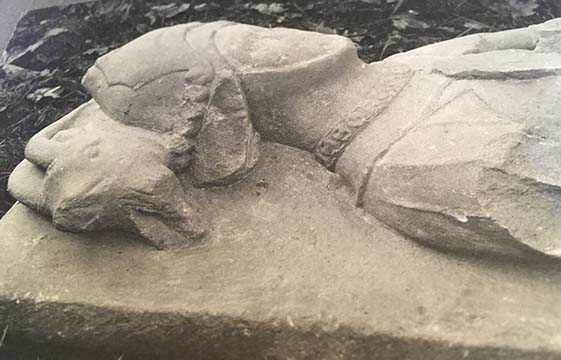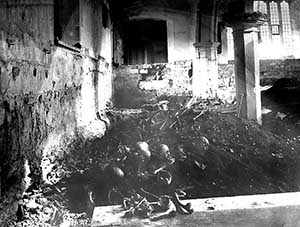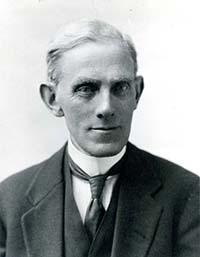

In the last year several of us have been preparing Visitor Guides for the three parish churches of the Castleberg benefice, Giggleswick, Settle and Rathmell. The guides should be ready for publication and display soon. The one that has taken longest to do is the one for St Alkelda’s, Giggleswick because the church, in vicar Julie’s words, “oozes with history”. Some material has had to be omitted in the basic Visitor Guide. A larger booklet is planned. Similarly, we also hope to publish new research material on St Alkelda.
Visitors to St Alkelda’s Church often wonder about the identity of the three mutilated effigy images now placed together in the north east corner of the church near the organ. One stone effigy is of Sir Richard Tempest, a 15th century knight of Knight Stainforth Hall, and next to him are stone effigies of his wives, Dame Mabel and Dame Sybil. Sir Richard’s effigy has lost both hands and part of the right foot while the other two effigies are decapitated and severely mutilated. Why were they so damaged? The answers came when the church floor was dug up during the restoration of 1890-92 and the effigies found separately buried in shallow earth graves amongst the skeletons under the floor. The local historian Thomas Brayshaw knew from records that the effigies of St Richard and his wives had been on view in the church but then had disappeared around 200 years before. We are indebted to Thomas Brayshaw for leaving in the parish archives details of what he had researched and for accompanying his written explanations with excellent black and white photos, now over 130 years old.
 One of the photos shows the skeletons in the area near the modern organ where the effigy of Sir Richard was found. These remains were eventually reverently reburied in an underground crypt beneath the new floor. The second photo shows the head of Sir Richard’s effigy to be in a better state than it is now. He is clad in the armour of a 15th century Lancastrian knight. He is wearing the Essess collar awarded by Lancastrian kings to loyal adherents. His helmeted head is lying on the head of a horned and bearded goat. On page 226 of A History of the Ancient Parish of Giggleswick, Brayshaw tells us that goats featured on the coat of arms of the Stricklands of Sizergh, and Mabel, the second Tempest wife, was a Strickland. Maybe that is the reason for the head rest.
One of the photos shows the skeletons in the area near the modern organ where the effigy of Sir Richard was found. These remains were eventually reverently reburied in an underground crypt beneath the new floor. The second photo shows the head of Sir Richard’s effigy to be in a better state than it is now. He is clad in the armour of a 15th century Lancastrian knight. He is wearing the Essess collar awarded by Lancastrian kings to loyal adherents. His helmeted head is lying on the head of a horned and bearded goat. On page 226 of A History of the Ancient Parish of Giggleswick, Brayshaw tells us that goats featured on the coat of arms of the Stricklands of Sizergh, and Mabel, the second Tempest wife, was a Strickland. Maybe that is the reason for the head rest.
Sir Richard Tempest of Stainforth, was born around 1425. He lived during the tumultuous period of the Wars of the Roses. The Lancastrian Henry VI proved a weak king, unable to halt the erupting feuds between Lancastrian and Yorkist factions. Giggleswick was on the Lancastrian side in the conflicts that followed. Richard Tempest fought at the battle of Wakefield in 1460 and was knighted by Henry VI for his loyalty and bravery. Thereafter, Richard seemed to have misgivings about Henry’s leadership and switched sides to support the Yorkists. For this act, in 1461, he was found guilty of treason and imprisoned in the Tower of London. In 1465, when the Lancaster cause seemed hopeless, he was pardoned by the Yorkist King, Edward IV. Sir Richard Tempest fought on the losing Yorkist side in the battle of Bosworth Field in 1485, and survived. Giggleswick, strongly Lancastrian, punished his effigy by chopping off the foot and two hands, both medieval punishments for treachery.

The discovery of Sir Richard’s buried effigy was made before those of his two wives. The pieces of the two decapitated effigies were found in the earth of the chancel amongst the skulls and skeletons of former parishioners. These too, were reverently reburied later. Thomas Brayshaw, on page 225 of A History of the Ancient Parish of Giggleswick describes what he saw when the pieces of the effigies were first removed from the ground in the chancel.
“Both figures are clothed in the garb of the Guild of Corpus Christi of York, and when they were first dug out of the ground the colours of the robes were very vivid, but are fading fast. They are habited in crimson cassocks, over which fall white cottas, short in the front but having yellow tassels from the neck to a little above the waist.”
The team had a mammoth task of fitting and glueing the pieces together. Great chunks of stone remained missing. In spite of an exhaustive search, the heads of the effigies were never found. Medieval Catholic beliefs enshrined in the Guild of Corpus Christi were heresy to the Protestant mind. As the effigy heads were the focal points of veneration, they probably were smashed to smithereens by the iconoclasts. Even though the effigies were just partially restored, the colours and splendour of the robes made a marked impression on the onlookers. Now, on the effigies, after over 130 years of exposure to the air, we can just make out a touch of red here and there.
The fact that the effigies were hastily dumped and buried in shallow earth, is a testimony to the contempt in which they were held, Although these objects were an abomination to the Protestant mind, they were not thrown out on to the common tip, but left to disintegrate, hidden below ground, in consecrated earth.
By Kathleen Kinder
Photo Credits: Giggleswick Church Archives. Centre / The Thomas Brayshaw Collections, Giggleswick School



